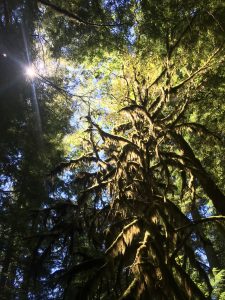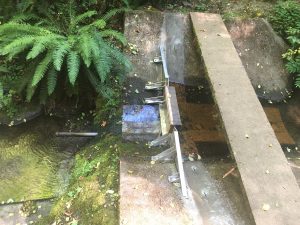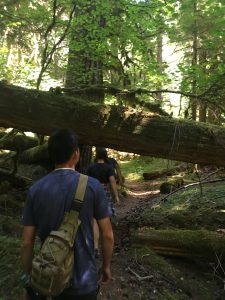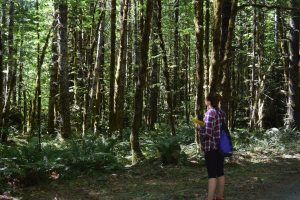HJA 1
What do you expect to observe when we visit the forests of the H.J. Andrews?
I imagine I would see mosquitos due to the excess rain, the trails will be neat while the rest of the woods will be cluttered with plantlife and wildlife. The forest will also be unlike anything I have seen before due to the various data collection methods by scientists in the forest and the authors that are welcomed to the forest to reflect on their observations and find inspiration.
What are some different ways of telling the story of these forests? How do methods of creative reflection support scientific inquiry and vice versa?
The story of the forest can be told through imagination, metaphor, direct experience, and research. Since scientists and professional writers are present in the forest, their perspectives are both unique. The various thoughts in the forest bring the arts, humanities, and science together. These different viewpoints of reflection in the forest help to protect the land and to become closer to it.
Why is the long-view critical to understanding the role of humans in the natural world?
Committing to long-term observation and reflection in the H.J. Andrews forests will hopefully keep the forests alive since they will have someone to speak on their behalf. Two hundred years of commitment to this program will likely help the forests and give people hope that the forests will still be there in the future.
HJA 2
Why was this theme chosen (e.g., Research and Revelation for Part One) to tell the story of the H.J. Andrews Experimental Forest?
Research and Revelation was chosen as the theme for this section because each of the pieces are related to the impact of science on understanding the forest. The authors each showcase how scientists, their equipment, and the data impact the forest in unique ways. Scientists use this forest as a space to collect data and it is important for the authors to reflect on this relationship.
What do you expect the landscape to look like from the passages in this section?
Upon entering the forest, I would expect a mountainous terrain, evergreen conifers, and Douglas fir trees. The land suffers from floods during the rainy seasons which is almost year-round and landslides can happen occasionally. The trees will be newer due to a forest fire in the 1800s. Additionally, there will likely be wet and dry meadows, a quiet “biophonic landscape” (Brodie, et al. 36), and data collection by scientists.
Provide an example or two of how the scientific context presented in the Ground Work essay is reflected in creative storytelling for the section.
On pages 63 and 64, the author first explains the ecological “stem maps” and their use in the H. J. Andrews Forest and second reflects on the maps’ contributions to understanding the forest. While the first paragraph is an exposition of the tree mapping, the second provides commentary on the impact of these maps. This style of writing is important to understanding the impact of the science taking place in the forest. Also, instead of a textbook-like style of writing, the author takes a much more interesting route. The Ground Work chapter on decomposition begins by explaining that “decomposition is not very sexy” (Brodie, et al. 84). This hook’s the reader immediately and provides a different type of experience for the audience than reading a Wikipedia article about the forest.
What’s a question you have about the forest from reading these passages?
This chapter on Research and Revelation frequently refers to the data collection taking place within the forest. To what extent do the scientists’ devices and materials take away from the beauty of the forest?
HJA 3
Why was this theme chosen (e.g., Research and Revelation for Part One) to tell the story of the H.J. Andrews Experimental Forest?
The author chose the theme Change and Continuity for this section because each piece discusses both the changing and constant aspects of the H. J. Andrews Forest. For instance, the author discusses the disturbances that occur in the forest which include floods and landslides. There are many changing pieces of the forest that are emphasized in this section.
What do you expect the landscape to look like from the passages in this section?
After reading this section, I imagine that the forest will be filled with Douglas fir trees, shrub fields, rocky patches, and streams. There will also be many elevation changes that will prove to be exhausting. Along the path, we may see barred owls, white trillium, redcedars, spotted owls, and possibly the sounds of coyotes.
Provide an example or two of how the scientific context presented in the Ground Work essay is reflected in creative storytelling for the section.
In the chapter Ground Work: Disturbance, the author describes a flood that took place in the Andrews Forest. He describes the storms as “wet ‘pineapple express’” ones. The author provided specific details of the flood, especially the observations of the “stalwart” researchers (Brodie, et. al 120). Additionally, in the chapter Ground Work: Northern Spotted Owl, the author explains the declination of the northern spotted owl population and current solutions to saving the species. The author uses an expository writing style to discuss the owl species and its current status in order to fulfill the common theme of change and continuity.
What’s a question you have about the forest from reading these passages?
Are there certain species in the H. J. Andrews Forest that have been declining in population over the years?
HJA 4
Why was this theme chosen (e.g., Research and Revelation for Part One) to tell the story of the H.J. Andrews Experimental Forest?
The theme for this section of the novel is Borrowing Other’s Eyes because each piece is written in order to place the reader in the observer’s shoes and to imagine what the author sees. The purpose of the theme is to connect the reader to the forest and to create a sense of belonging for the reader. Most readers have not visited this forest or are about to and it is important that they are able to picture themselves in this environment.
What do you expect the landscape to look like from the passages in this section?
I expect to see water everywhere. In the Ground Work section on Water, the author describes the damp landscape and the excessive rainfall each year. Although in August there may not be as much rain, it rains the rest of the year. There are also likely to be mosquitoes since the forests are damp.
Provide an example or two of how the scientific context presented in the Ground Work essay is reflected in creative storytelling for the section.
In the Ground Work section on Water, the author illustrates the extent of rainfall the forest receives. He walks you through the forest and explains the feeling of dampness in the air as well as the sweat from trekking into the forest. Through the specific descriptions, one can truly imagine how much water is in Portland. The author’s style is similar in Soundscape since it is extremely vivid.
What’s a question you have about the forest from reading these passages?
Since the forest receives so much rain most of the year, are there times when the forest does not receive the proper amount of rain, thus affecting the wildlife and plants?





Rachel,
Regarding your question about researchers’ materials in HJA 2, did you find the experiments set up around the forest to be disruptive? How often did you notice them? Do you think altering the environment in the ways the HJA researchers do is ethical? Does whether it’s ethical depend on the importance of the results obtained from their research?